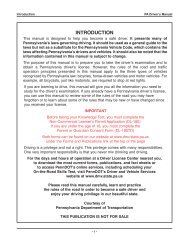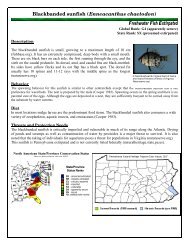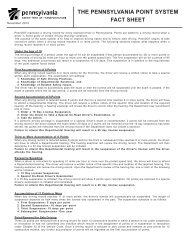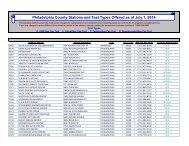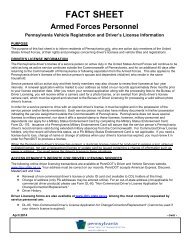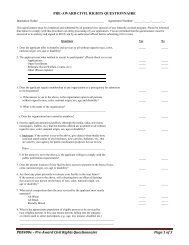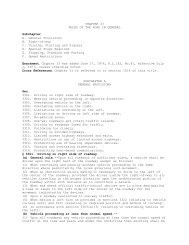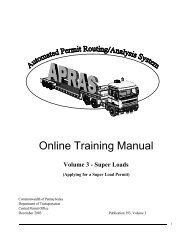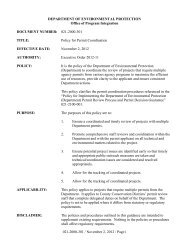fundamentals of driving a school bus - PennDOT Driver and Vehicle ...
fundamentals of driving a school bus - PennDOT Driver and Vehicle ...
fundamentals of driving a school bus - PennDOT Driver and Vehicle ...
- No tags were found...
You also want an ePaper? Increase the reach of your titles
YUMPU automatically turns print PDFs into web optimized ePapers that Google loves.
UNIT G - Fundamentals <strong>of</strong> Driving a School BusFor example, if the distance from your reference point to your front bumper measures 18 feet, you will knowthat whenever you are sitting in the driver’s seat, the point on the ground you see directly in front <strong>of</strong> the hood<strong>of</strong> your <strong>bus</strong> is 18 feet from the front bumper. This will be helpful for determining the proper distance to stop atrailroad grade crossings.For determining reference points to the side or rear <strong>of</strong> your <strong>bus</strong>, make sure you are seated comfortably in yourseat with seat belt attached. Then, mark points on the various outside rear view mirrors on either side <strong>of</strong> your<strong>bus</strong>.To determine the point directly below your rear bumper, use a point in your left (or right) rear view mirror thatlines up directly over the bottom <strong>of</strong> your left rear wheel well <strong>and</strong> your rear bumper. Now measure the distancefrom this point on the ground to the edge <strong>of</strong> your rear bumper. Remember this distance. You should usereference points on both left <strong>and</strong> right rear mirrors.This rear reference point can be helpful when estimating the distance from your rear bumper to some point onthe ground <strong>and</strong> can be especially helpful at a railroad grade crossing when determining the distance <strong>of</strong> yourrear bumper from the track.Finally, remember these measurements should be made <strong>and</strong> will only be applicable on level ground. Adjustyour front <strong>and</strong> rear measurements when your <strong>bus</strong> is stopped on a sloped surface.KNOW YOUR ROUTEYou’ll be more confident <strong>and</strong> be a safer driver when you become completely familiar with the route you drive.You must know what to do with hazards on your route. For example, some intersections are more hazardousdue to limited sight or an area with poor drainage that floods.Follow the local policy <strong>and</strong> procedures for reporting hazardous stops/routes. If possible, come up with asolution to the problem. Changing the <strong>bus</strong> route or <strong>bus</strong> stop location might solve the problem. The townshiproad supervisor might be able to make some changes to the roadway to correct the problem. You coulddesignate a place for your students to st<strong>and</strong> when the snow is piled up.There are some hazards that are unavoidable. By being aware <strong>of</strong> the potential hazards on your route, you willbe better prepared for the challenge.On the route schedule you keep in your <strong>bus</strong>, make notes <strong>of</strong> the route hazards, so if there is ever a substitute<strong>bus</strong> driver on your route, they will have this knowledge, too.FIELD TRIP / ATHLETIC TRIP CONCERNSField trips can present some new situations you haven’t experienced, if you are a new driver. Particularsituations that might arise could include the following:• Wondering if the <strong>bus</strong> will fit (on a street, in a parking area);• One-way streets;• Fueling;• Tolls;Pennsylvania School Bus <strong>Driver</strong>’s Manual • PUB 117 G-5



